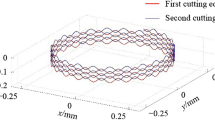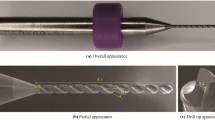Abstract
DD6 nickel-based superalloy is a typical refractory material, and has important applications in the aviation industry. Ultrasonic-assisted drilling can greatly enhance the processability of refractory materials. The presence of burrs will affect assembly, and the extra process to remove burrs will reduce production efficiency and increase production costs. Compared with conventional drilling, ultrasonic-assisted drilling can distinctly reduce the burr height. It is very necessary to model and predict the burr height of ultrasonic-assisted drilling. A prediction model of exit burr for ultrasonic-assisted micro drilling is proposed. A new thrust force model is developed by considering the dynamic cutting speed, dynamic cutting thickness, and the acoustic softening effect. The newly established ultrasonic-assisted drilling thrust force model was used to modify the conventional drilling burr height model, and the burr height was calculated. The accuracy of the model is verified by ultrasonic-assisted drilling experiments under different feed rates, spindle speeds, frequencies, amplitudes, and point angles of the bit. The minimum error of the average burr height prediction value is 4.5%, and the maximum error is 17.7%. The model has great significance in the prediction of burr height in ultrasound-assisted micro-hole drilling.

















Similar content being viewed by others
Data availability
All authors confirm that the data supporting the findings of this study are available within the article.
Abbreviations
- f z :
-
Feed per revolution (mm/r)
- n :
-
Spindle speed (r/s)
- t :
-
Time (s)
- f :
-
Vibration frequency (Hz)
- A :
-
Amplitude (μm)
- t a :
-
Axial uncut chip thickness (mm)
- t i :
-
Instantaneous uncut chip thickness (mm)
- ϕ:
-
Half-point angle (°)
- r :
-
Radial distance of the drill bit (mm)
- h :
-
Helix angle (°)
- F n :
-
Normal force (N)
- F f :
-
Friction force (N)
- A c :
-
Area of the uncut chip (mm2)
- K n :
-
Specific normal force (N/mm2)
- K f :
-
Specific friction force (N/mm2)
- v c :
-
Cutting speed (mm/s)
- α n :
-
Normal rake angle (°)
- i :
-
Inclination angle (°)
- l chi :
-
Length of the chisel edge (mm)
- ηc :
-
Chip flow angle (°)
- ψ:
-
Chisel edge angle (°)
- dF mcut :
-
Elemental cutting force in main cutting edge (N)
- dF mthu :
-
Elemental oblique cutting thrust force in main cutting edge (N)
- dF mlat :
-
Elemental lateral force in main cutting edge (N)
- dF ccut :
-
Elemental cutting force in chisel edge (N)
- dF cthu :
-
Elemental thrust force in chisel edge (N)
- v p :
-
Poisson’s ratio of the workpiece material
- ω:
-
Circular frequency (rad/s)
- s :
-
Wave velocity
- E :
-
Young’s modulus
- F r c cin :
-
Reduction in indentation force (N)
- k :
-
Constant related to material
- F ccin :
-
Indentation force in conventional drilling (N)
- F zTotal :
-
Total thrust force in ultrasonic assisted drilling (N)
- F cin :
-
Indentation force in ultrasonic assisted drilling (N)
- f(t):
-
Instantaneous feed rate (mm/s)
- ΔW T :
-
Total work
- ΔW th :
-
Work for drilling
- ΔW df :
-
Work for material deformation
- h 0 :
-
Critical thickness (mm)
- R :
-
Radius of the bit (mm)
- εab :
-
Logarithmic strain
- V :
-
Volume of the deformed material (mm3)
- σy :
-
Yield strength (Mpa)
- Δθ:
-
Bending angle (rad)
- εp :
-
Effective plastic strain
- εf :
-
Fracture strain
- H :
-
Burr height (mm)
- %R.A. :
-
Percentage of material area reduction at tensile fracture
- SP :
-
Sensitivity percentage
- Δf(x i):
-
Change rate of burr height
References
Peng Y, Li J, Peng X, Li S, Xiong J, Shi J (2020) Interfacial microstructure evolution and formation process of the joints prepared by diffusion bonding on DD6 nickel-based single crystal superalloy. J Mater Sci Technol 9:16317–16328
Pei H, Wen Z, Yue Z (2017) Long-term oxidation behavior and mechanism of DD6 Ni-based single crystal superalloy at 1050°C and 1100°C in air. J Alloy Compd 704:218–226
Xu Q, Zhang Y (2020) Precipitation and growth simulation of γ′ phase in single crystal superalloy DD6 with multiphase-field method and explicit nucleation algorithm. Metals 10:1346
Giasin K, Ayvar-Soberanis S (2017) An investigation of burrs, chip formation, hole size, circularity and delamination during drilling operation of GLARE using ANOVA. Compos Struct 159:745–760
Biermann D, Hartmann H (2012) Reduction of burr formation in drilling using cryogenic process cooling. Procedia CIRP 3:85–90
Yang Z, Zhu L, Lin B, Zhang G, Ni C, Sui T (2019) The grinding force modeling and experimental study of ZrO2 ceramic materials in ultrasonic vibration assisted grinding. Ceram Int 45:8873–8889
Kandi R, Sahoo SK, Sahoo AK (2020) Ultrasonic vibration-assisted turning of titanium alloy Ti–6Al–4V: numerical and experimental investigations. J Braz Soc Mech Sci 42(8):1–17
Fang B, Yuan Z, Li D, Gao L (2021) Effect of ultrasonic vibration on finished quality in ultrasonic vibration assisted micromilling of Inconel718. Chinese J Aeronaut 34:209–219
Makhdum F, Jennings LT, Roy A, Silberschmidt VV (2012) Cutting forces in ultrasonically assisted drilling of carbon fibre-reinforced plastics. J Phys Conference series 382:12019
Makhdum F, Phadnis VA, Roy A, Silberschmidt VV (2014) Effect of ultrasonically-assisted drilling on carbon-fibre-reinforced plastics. J Sound Vib 333:5939–5952
Alam K, Mitrofanov AV, Silberschmidt VV (2011) Experimental investigations of forces and torque in conventional and ultrasonically-assisted drilling of cortical bone. Med Eng Phys 33:234–239
Zhang X, Yu T, Wang W, Zhao J (2019) Improved analytical prediction of burr formation in micro end milling. Int J Mech Sci 151:461–470
Aziz M, Ohnishi O, Onikura H (2012) Innovative micro hole machining with minimum burr formation by the use of newly developed micro compound tool. J Manuf Process 14:224–232
Dornfeld D, Min S (2010) A review of burr formation in machining. Burrs-analysis, control and removal, 3–11
Jin SY, Pramanik A, Basak AK, Prakash C, Shankar S, Debnath S (2020) Burr formation and its treatments—a review. Int J Adv Manuf Tech 107:2189–2210
Gillespie LK, Blotter PT (1976) The formation and properties of machining burrs. Journal of Engineering for Industry 98:66–74
Chern G, Dornfeld DA (1996) Burr/Breakout model development and experimental verification. J Eng Mater-T ASME 118:201–206
Sung-Lim K, Dornfeld DA (1996) Analysis of fracture in burr formation at the exit stage of metal cutting. J Mater Process Tech 58:189–200
Pramanik A, Basak AK, Uddin MS, Shankar S, Debnath S, Islam MN (2019) Burr formation during drilling of mild steel at different machining conditions. Mater Manuf Process 34:726–735
Ko SL, Chang JE, Kaipakjian S (2003) Development of drill geometry for burr minimization in drilling. CIRP Ann 52:45–48
Varatharajulu M, Loganathan C, Baskar N (2015) Influence of cutting parameters on burr height and burr thickness in drilling of duplex 2205 using solid carbide. Int J Chemtech Res 8:768–777
Rezende B, Silveira M, Vieira L, Abrão A, Faria P, Rubio J (2016) Investigation on the effect of drill geometry and pilot holes on thrust force and burr height when drilling an Aluminium/PE sandwich material. Materials 9:774
Kim J, Dornfeld DA (2002) Development of an analytical model for drilling burr formation in ductile materials. J Eng Mater-T ASME 124:192–198
Chang SSF, Bone GM (2010) Burr height model for vibration assisted drilling of aluminum 6061–T6. Precis Eng 34:369–375
Bu Y, Liao WH, Tian W, Shen JX, Hu J (2016) An analytical model for exit burrs in drilling of aluminum materials. Int J Adv Manuf Tech 85:2783–2796
Li S, Zhang D, Liu C, Tang H (2020) Exit burr height mechanistic modeling and experimental validation for low-frequency vibration-assisted drilling of aluminum 7075–T6 alloy. J Manuf Process 56:350–361
Zai P, Tong J, Liu Z, Zhang Z, Song C, Zhao B (2021) Analytical model of exit burr height and experimental investigation on ultrasonic-assisted high-speed drilling micro-holes. J Manuf Process 68:807–817
Flachs JR, Salahshoor M, Melkote SN (2014) Mechanistic models of thrust force and torque in step-drilling of Al7075-T651. Prod Eng Res Devel 8:319–333
Gong Y, Lin C, Ehmann KF (2005) Dynamics of initial penetration in drilling: part 1—mechanistic model for dynamic forces. J Manuf Sci E-T ASME 127:280–288
Anand RS, Patra K, Steiner M, Biermann D (2017) Mechanistic modeling of micro-drilling cutting forces. Int J Adv Manuf Tech 88:241–254
Yang H, Ding W, Chen Y, Laporte S, Xu J, Fu Y (2019) Drilling force model for forced low frequency vibration assisted drilling of Ti-6Al-4V titanium alloy. Int J Mach Tool Manu 146:103438
Mao Q, Coutris N, Rack H, Fadel G, Gibert J (2020) Investigating ultrasound-induced acoustic softening in aluminum and its alloys. Ultrasonics 102:106005
Funding
This work is supported by National Natural Science Foundation of China (Grant No. 51775443), National Science and Technology Major Project (Grant No. 2017-VII-0015–0111), and China Postdoctoral Science Foundation (Grant No. 2020M683569). National Natural Science Foundation of China,51775443,Wenhu Wang,National Science and Technology Major Project,2017-VII-0015–0111,Wenhu Wang,China Postdoctoral Science Foundation,2020M683569,Yifeng Xiong
Author information
Authors and Affiliations
Contributions
Xiaoxiang Zhu: experiment and manuscript writing. Wenhu Wang: project administration and funding acquisition. Ruisong Jiang: review and editing. Yifeng Xiong: review and editing. Xiaofen Liu: review and editing.
Corresponding author
Ethics declarations
Ethics approval
The manuscript has not been submitted to any other journal for simultaneous consideration. The submitted work is original and has not been published elsewhere in any form or language.
Consent to participate
All authors voluntarily agree to participate in this research study.
Consent for publication
All authors voluntarily agree to publish in this research study.
Conflict of interest
The authors declare no competing interests.
Additional information
Publisher's Note
Springer Nature remains neutral with regard to jurisdictional claims in published maps and institutional affiliations.
Rights and permissions
About this article
Cite this article
Zhu, X., Wang, W., Jiang, R. et al. Modeling of burr height in ultrasonic-assisted drilling of DD6 superalloy. Int J Adv Manuf Technol 120, 2167–2181 (2022). https://doi.org/10.1007/s00170-021-08524-y
Received:
Accepted:
Published:
Issue Date:
DOI: https://doi.org/10.1007/s00170-021-08524-y




